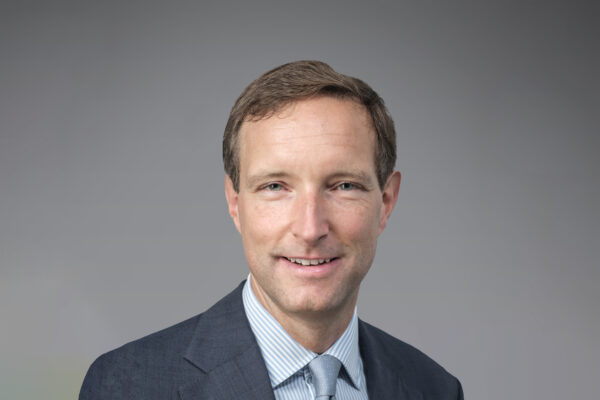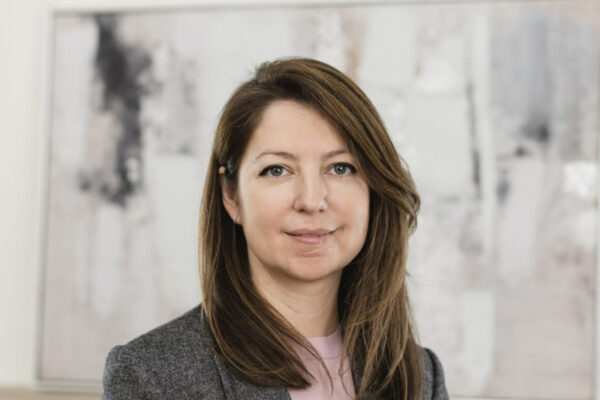
While bonds are undoubtedly back at the centre of investment preferences, after several years on the margins, it is vital to focus on transformational trends in both geopolitics and sustainability in order to maximise profits
Henrietta Pacquement, the French portfolio manager who runs global fixed income for Allspring Global Investments from her office in London, laughs uproariously when she sees the FT Weekend supplement cover story, focusing on the re-emergence of bonds from the investment wilderness.
“It’s great to be at the centre of things again,” she says, unable to hide her joy at the market’s return to something approaching normality, following “an extraordinary period of financial repression” and low interest rates.
“You have got various areas of the market that have been very much unloved, particularly on the European side with very low or negative rates. Suddenly, investors — who were underallocated in those areas — are looking at euro investment grade, for instance, and adding allocations there, as rates have risen. When is the last time we saw four per cent yields for investment grade in Europe?”

A likely era of prolonged higher interest rates — benefiting fixed income above equities — will hold for some time, believes Amin Rajan, CEO of the Create-Research consultancy, speaking on the sidelines of the IMPower FundForum event in Monaco in June.
“Climate action will be hugely inflationary, because we need to spend $2tn to $5tn every year on adapting our current energy infrastructure, and this is really going to weigh heavily on raw materials like copper, for example, or lithium,” says Mr Rajan.
Moreover, a new era of geopolitical tensions will diminish appetite for cross-border outsourcing, instead favouring ‘reshoring’, which will create inflationary domestic capacity. Additionally, a lack of investment into traditional manufacturing sectors over the past 15 years, when high-tech manufacturing has been a priority, will soon be reversed, creating further inflation.
Against this backdrop, portfolio investors will favour fixed income for attractive yields; operational efficiency, as it can be done cheaply in house; and to fulfil capital conservation needs.
Fixed income savagery
“Investors are now moving into bonds on an opportunistic basis, to take advantage of the ‘savagery’ we have seen in fixed income markets last year, for example,” says Mr Rajan, commenting on the “biggest dislocation” that markets have witnessed.
But he urges caution, weighing up opportunities of active bond trading versus buy-and-hold approaches. “There is a widespread feeling today that those who try to time the market … can end up losing a lot of money. The investing graveyard is full of chief investment officers who tried to time the markets, and therefore there is much less appetite for opportunistic investing,” reflects Mr Rajan.
“But it is still there, particularly when there is such huge dislocation.”
In every region monitored by Citi Private Bank, allocations to bonds rose in the second quarter of 2023, with family offices favouring investment grade and US Treasuries “now offering income that they have not for many years,” as well as diversification benefits.
“Most of the activity within investment grade bonds is centred on government issuances and financials,” according to Citi’s research, based on data collected from 1200 single family offices, with investible assets of more than $250m.
This is in line with Citi Global Wealth’s ‘bonds are back’ tactical messaging. “Investors have been locking in attractive fixed income portfolio yields for 5–6 years, at levels much higher than estimated cash yields over the same horizon,” says Citi.
In a report released on 27 August, Citi’s global head of investments, David Bailin, recommends adding further to clients’ fixed income allocations, particularly in the US, highlighting the market’s negative positioning.
A fixed income rally could be driven by signs that the US is not sustaining miraculously strong growth
“We believe this positioning is indicative of the fear that [US Federal Reserve chair Jerome] Powell will continue to raise rates, and a secondary view that inflation will rise again,” suggests Mr Bailin.
“Following a strong performance of equities in the first half of 2023 — driven by a covering of record high short positions — we may see a rally in fixed income next. This could be driven by any signs that the US is not sustaining miraculously strong growth.”
New generations, new strategies
Many of the younger, more recent recruits to bond investing, however, require a new approach to fixed income. The next generation of investors — beneficiaries of assets and responsibilities handed down by their parents — have been living for some time with low yields, and have typically already dipped their toes into riskier waters of private or ‘alternative’ fixed income to compensate.

“We spend a lot of time discussing these points with clients,” says Frédéric Rochat, managing partner of Geneva-based private bank Lombard Odier, lamenting the “tough performance” across client portfolios during a period of rising interest rates in 2022, as both equity and bond values slumped, prompting repricing of risk premiums.
“We don’t see bonds and alternatives as antagonistic, but as a complement to each other,” says Mr Rochat. “In fact, it all starts with the bonds. Bond portfolios and credit portfolios are both back in favour, which is very important for us, as for the last few years, nobody wanted to buy a new bond portfolio.”
This situation has now changed. “Today, you can get an almost risk-free US Treasury bond, yielding four to five per cent, which is great news. Add in some decent credit spreads, with good-quality names, and you add one to two per cent to your performance. Bonds are definitely back in favour.”
But the way clients should take advantage of these opportunities remains a hot topic with private bankers. “Implementation is key. Many of our clients don’t like the idea of a bond fund,” says Mr Rochat. “Many of them prefer the transparency of holding every single fixed income line in their portfolio, to assess for themselves the credit name behind it and keep track of maturities.”
This style of investing can become a lot more intricate, however. “There is another way to look at bond investing, where we don’t just use the long-only strategy, but deploy an alternative,” says Mr Rochat. “We have looked at that in a lot of detail and developed our own expertise in alternative investment on the bond side,” he says, describing long–short investments pioneered through Lombard Odier’s 1798 credit arbitrage strategy, based out of New York.
This has proved “extremely helpful” during times of market turbulence, such as March 2020 — or the entirety of 2022 — when the old 60:40 allocation system was temporarily shelved by many wealth managers. “When rates are going up or there is a change of cycle, you can have instances when traditional portfolio diversification does not work anymore, and both bonds and equities are going down, which is what happened in 2022,” he says.
“So, we have been looking at the credit arbitrage market as one of the sources of decorrelation to effectively help add resilience to a 60:40 portfolio,” says Mr Rochat. “We have done that with credit arbitrage strategies, which are basically strategies that, in a normal environment, will manage to cover their costs and deliver single-digit returns to the investor. Yet in an environment of market stress and heightened volatility they can do well, due to their convex return profile achieved though active dislocation screening, analysis and trade structuring. In such market circumstances, these strategies can perform strongly and add important portfolio diversification.”
Friends in high places
Portfolio investors currently have several ‘friends’ to help plan allocations. Firstly, this includes central bankers — the pattern of whose rate rises, announcements and policy papers are required reading for fixed income afficionados.
Central banks have been very quick and effective, and have seemingly stopped the rot. Lessons have been learned
“They have had a lot of opportunities to sharpen their toolbox over the past 20 years,” confirms Allspring’s Ms Pacquement. “For me, the latest example of that is what the Fed has done with the issues with Credit Suisse and regional banks. They have been very quick and effective, and have seemingly stopped the rot. Lessons have been learned.”
Secondly, the quality of data is improving fast, particularly when it comes to assessing the impact of investments on climate change. “Data on the equities side has been richer than what has been available in fixed income, with arguably more done on the equity side from a sustainability perspective, but data on fixed income has improved,” argues Ms Pacquement, highlighting the role of specialist green, social and sustainability bonds.
Investors are increasingly observing corporate debt portfolios through the climate lens, building up a better understanding of companies’ environmental strategies.
“What are they going to do to adapt to net-zero going forwards? We are not necessarily focusing in on certain projects,” she says, “but understanding what a company is doing, in terms of their starting place, their assets, operating capabilities and how are we are going to help them evolve to meet decarbonisation demands over the next few years.”
Some commentators, including Mr Rajan of Create-Research describe “explosive growth” in green funds, green bonds, social bonds and sustainability-linked bonds. “That growth is likely to continue because it gives investors a lot of comfort,” he says, as securities issuers look to prove they can both mitigate climate change and stimulate social progress.
Specialist firms see this as a huge opportunity, investing in areas such as “transitional bonds” issued by companies that are both leaders in their sectors and beginning to tackle climate change.

“Even though we invest in fixed income, we build equity models on the growth structure of the company,” says Maria Lozovik, CEO of Marsham Investment Management, who typically deploys 30 to 50 bonds in one of her portfolios. “We’re not buying green companies,” she stresses, but rather those whose climate change credentials are improving.
Her rationale of focusing on fixed income, rather than equity, is that Marsham’s natural audience of family offices, with their semi-institutional mentality, have a natural affinity for this asset class.
“I regularly see more interest especially from third- and fourth-generation family offices, with single-family houses getting more interested in the climate angle. But the majority of clients are predominantly focused on returns, capital preservation and the dividend stream for the funds or the coupon stream from the portfolio, so they are mostly interested in financial metrics.”
Russian invasion
For these fixed income investors, Russia’s invasion of Ukraine marks a major inflection point, believes Ms Lozovik, especially when it comes to diversifying sources of energy for the European continent. “I think a big impact on Europe from the war is that it forces energy transition within Europe.
“Europe has been stagnating for the last 15 years … it’s a very mature market, with very mature industries. It needs a structural shift to be able to find growth.”
Currently, this impetus is coming from energy transition. “I think, for Europe, this is the only way out of recession,” says Ms Lozovik, expecting Europeans to substitute bulk gas purchases with infrastructure investment for renewables.
If Europe invests heavily into production of hydrogen ... all of this generates massive employment and job creation
“If they invest heavily into production of hydrogen and other sources of renewable energy within Europe — involving huge infrastructural projects, pipelines and grids — all of this generates massive employment and job creation for Europe.”
Provided Europe (and Germany in particular) can overcome political hurdles, a positive story emerges for nuclear, hydrogen and solar industries, explains Ms Lozovik, with electricity providers able to create gross domestic product within Europe, rather than importing resources.
She is also looking forward to investing in bonds that will help to rebuild the Ukrainian economy, once the time is right. “It will probably start with private investments that will then go to the public space as soon as there are public bonds outstanding. We will definitely look to be investors, as this should be a fantastic growth opportunity,” she says.
Marsham is not alone in addressing the “difficult questions” which Russia’s invasion of Ukraine has raised among debt investors. “One such question is how best to approach illiberal and autocratic countries, like Russia, within the asset class,” write GMO’s fixed income strategists Eamon Aghdasi and Mina Tomovska, in an August paper titled ‘Does democracy matter for emerging sovereign debt?’
This question, the authors believe, has become more important than ever in the wake of a relatively undemocratic country within emerging debt benchmarks attacking a relatively democratic one, particularly amid continued investor interest in environmental, social and governance sustainability.
Their suggestion is for investors to develop an emerging market debt portfolio prioritising freedom and democracy, while preserving the asset class’s key investment characteristics. “We believe such an approach may help investors reduce exposure to certain costly political events akin to the ones witnessed in 2022,” write the GMO experts. “At the very least, it should help sustainably conscious investors to establish emerging debt portfolios that are freer, more democratic and better aligned with their own values.”
Industry voices are, however, agreed that analysts have failed to spot key recent tail risks, including the market effects of Brexit, Covid and Russia’s invasion, despite the prolonged build-up of Moscow’s troops on its neighbour’s border.
Irrational decisions
“The trigger for me [to expect an invasion] was when the Russians started building field hospitals,” explains Ms Pacquement. “But it was never the rational decision for Putin to go in — if you look at the length of the front and size of Ukraine, the probability of Russian success was always low. Russia has got itself bogged down and there is no end in sight.”
The fixed income specialist always looks at what is likely to go wrong
After the failure of most investment groups to spot the events which triggered huge food shortages, widespread inflation and geopolitical realignments reshaping trade patterns, the fixed income units of investment management firms will definitely be beefing up geopolitical research for future needs, she adds.
“The pattern we are seeing now revolves around a complex situation, including interesting thematics linking macro-economic and political situations,” she says. “You have the whole ecosystem around the auto sector, which is changing, as the value chain is transforming and we need to look at how it will impact the competitive landscape. We need to look at the role of Germany, de-risking, US and Chinese relations and how all of that plays out. There is more complexity than we are used to and more of a balancing of powers between the East and West.”
Fixed income experts, believes Ms Pacquement, are better at analysing these scenarios than counterparts in equity markets. “This is because we are pessimists,” she laughs. “The fixed income specialist always looks at what is likely to go wrong, as opposed to the equity strategist who is talking about a positive outcome. And not only that, we are probably more well-versed on what keeps an economy ticking.”


